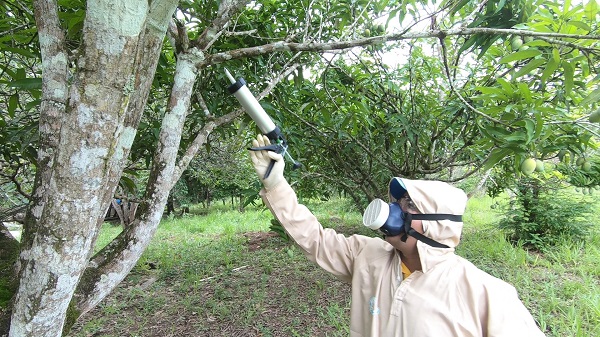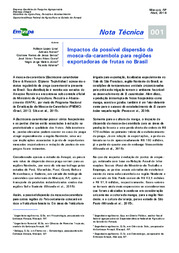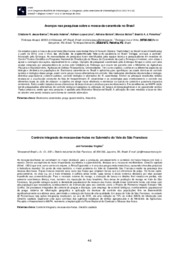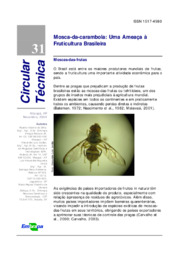Research to control carambola fruit fly is funded by International Atomic Energy Agency
Research to control carambola fruit fly is funded by International Atomic Energy Agency
In response to the risks imposed by the carambola fruit fly (Bactrocera carambolae) to Brazilian agriculture, especially national fruit farming, several control methods are used to suppress the population of the pest. In that sense, Embrapa developed an unprecedented project aimed at assessing B. carambolae's behavior and survival when submitted to different semiochemicals to inform the simultaneous application of the male annihilation technique (MAT), through the use of the chemical attractant methyl eugenol, and the Sterile Insect Technique (SIT), the breeding and mass release of male insects that have been sterilized through ionized radiation.
The proposal is funded by the International Atomic Energy Agency (IAEA), with the aim of jointly developing SIT for fruit fly control with other country participants. About 30,000 euros were allocated for the project, which is due to last for five years, led by the researcher Cristiane Ramos de Jesus from Embrapa Amapá, partner researchers from Embrapa Temperate Agriculture, Embrapa Semi-arid Region, the Federal University of Alagoas (Ufal) and the Federal University of Amapá (Unifap).
| Understand how the study will take place Alternative semiochemicals made of volatile compounds from host fruits and Amazon plant oils will be used to assess their effects on sexual competitiveness (i.e. mating frequency, performance and copulation parameters), as well as on the reduced response time of male B. carambolae attraction to methyl-eugenol. Such information will potentialize the action of pest monitoring and detection traps and will inform the simultaneous application of the MAT and SIT techniques. The experiments will be held at Embrapa Amapá's Plant Protection Building and at the orchard in their experimental field. |
IAEA is an é intergovernmental organization headquartered in Viena, Austria, considered the world's central forum for scientific and technical cooperation in the nuclear field. It works for the safe, secure and peaceful uses of nuclear science and technology. IAEA and the Food and Agriculture Organization of the United Nations (FAO) jointly work to collaborate with member countries and instruct them to safely and adequately use such technologies.
The project “Effect of semiochemicals on the behavior and survival of carambola fruit flies and on methyl-eugenol attraction response time to inform pest management in Brazil" is one of the components that will contribute to achieving the IAEA/CRP goal, which is to explore the potentially synergistic relationship between MAT and SIT when simultaneously applied to enhance Bactrocera management, and assess the semiochemicals used.
Cristiane Ramos de Jesus, the project leader, underscored that “the proposal's success will provide another alternative to control carambola fruit flies, and can be applied as part of integrated pest management in South American countries affected by B. carambolae”. The investigation of male behavioral responses to the use of methyl eugenol and other semiochemicals will yield relevant scientific evidence that the simultaneous application of SIT and MAT can effectively suppress or even eradicate carambola fruit flies in South America. “There are new tools to control the pest, in adddition to the expanded networking with Bactrocera experts from other countries”, the researcher added.
Carambola fruit fly in Brazil
Carambola fruit flies are a quarantine pest whose presence in Brazil has been restricted to the Northern states of Amapá, Pará and Roraima, officially controled by the Ministry of Agriculture, Livestock and Food Supply (MAPA). It causes damages not only to the starfruit tree, but also to guava, Barbados cherry, mango and other fruit trees from a list of 21 hosts in Amapá. Originarily from the Asian Southeast, it is considered an invasive species in Brazil, Suriname, Guyana and French Guyana. In Brazil, it was first recorded in 1996 in Oiapoque, in Amapá's far North. The studies led by Embrapa Amapá respond to demands from the National Program to Eradicate Carambola Fruit Flies(PNEMC), coordinated by the Ministry of Agriculture with the purpose of promoting research for the biological security and zoo-phytosanitary defense of Brazilian agricultural and forestry production.
Translation: Mariana Medeiros
Aline Furtado (Conrerp/DF: 1575)
Embrapa Amapá
amapa.imprensa@embrapa.br
Phone number: +55 96 3203-0278
Further information on the topic
Citizen Attention Service (SAC)
www.embrapa.br/contact-us/sac/




